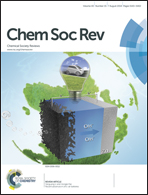Heterogeneous electron transfer at nanoscopic electrodes: importance of electronic structures and electric double layers
Abstract
Heterogeneous electron-transfer (ET) processes at solid electrodes play key roles in molecular electronics and electrochemical energy conversion and sensing. Electrode nanosization and/or nanostructurization are among the major current strategies for performance promotion in these fields. Besides, nano-sized/structured electrodes offer great opportunities to characterize electrochemical structures and processes with high spatial and temporal resolution. This review presents recent insights into the nanoscopic size and structure effects of electrodes and electrode materials on heterogeneous ET kinetics, by emphasizing the importance of the electric double-layer (EDL) at the electrode/electrolyte interface and the electronic structure of electrode materials. It is shown, by general conceptual analysis and recent example demonstrations of representative electrode systems including electrodes of nanometer sizes and gaps and of nanomaterials such as sp2 hybridized nanocarbons and semiconductor quantum dots, how the heterogeneous ET kinetics, the electronic structures of electrodes, the EDL structures at the electrode/electrolyte interface and the nanoscopic electrode sizes and structures may be related.


 Please wait while we load your content...
Please wait while we load your content...